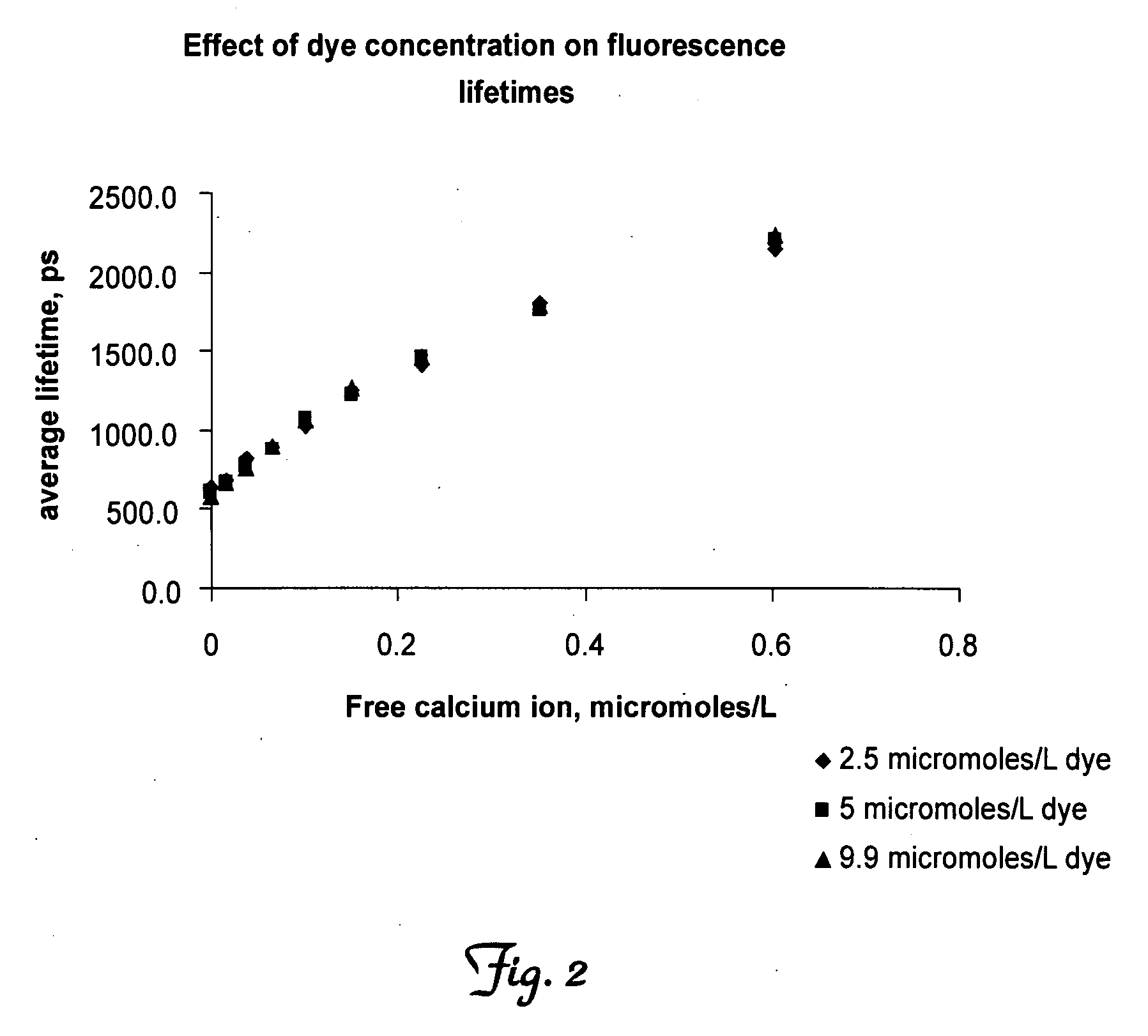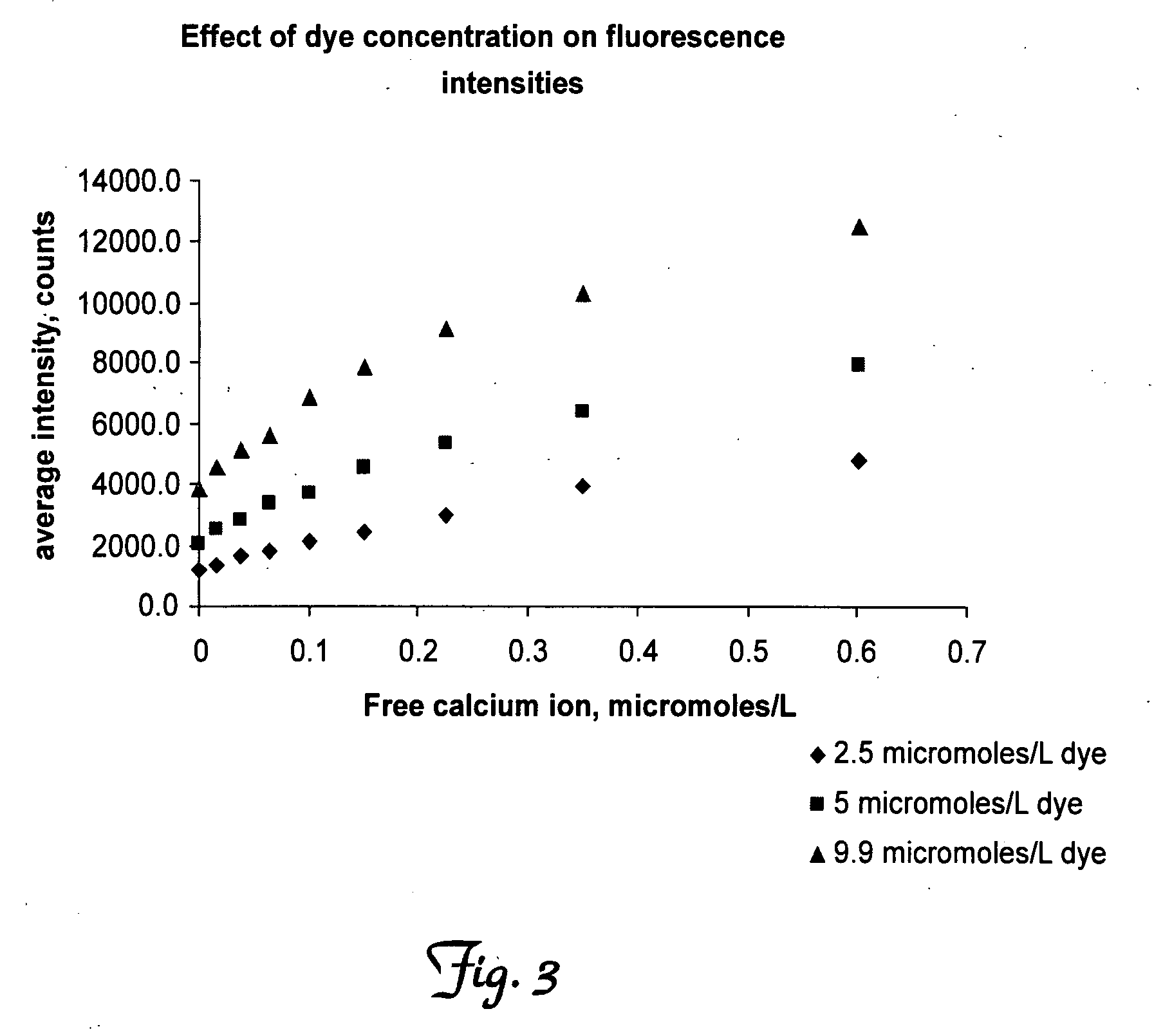Methods for determining cellular response to stimuli
a technology of cellular response and stimuli, applied in the direction of material analysis, instruments, biological material analysis, etc., can solve the problems of limited development of new agents that mimic or block the basic tastes, high calories, and many taste-mimicking or taste-blocking agents developed to-date are not suitable food additives
- Summary
- Abstract
- Description
- Claims
- Application Information
AI Technical Summary
Problems solved by technology
Method used
Image
Examples
example 1
Multiphoton Fluorescence Lifetime Imaging System Characterization: Response to Calcium Green Dextran Solutions of Known Free Calcium Concentration
[0099] The present inventors made use of a multiphoton lifetime fluorescence imaging microscopic (MP-FLIM) system capable imaging calcium dynamics within taste cells in intact, live porcine taste tissue. The approach made use of a calcium sensitive fluorescent dye (calcium green-1 dextran MW=3000), where the dye emission properties (fluorescence lifetime and intensity) were perturbed by intracellular calcium concentration changes in the nanomolar to millimolar range. Multiphoton-excited fluorescence, in this case, made use of a pulsed near-infrared laser to excite fluorescence from a visible fluorophore via a two or three photon process. This non-linear optical process allowed for deep tissue imaging of fluorophore emission with minimal cell damage from the near-infrared laser due to lack of absorption outside of the focal plane and absen...
example 2
Quantitative Algorithm Development and Estimation of System Optical Performance
[0109] There are a number of tasks involved to ensure precise and robust measurement of changes that occur in the image data obtained from the MP-FLIM system. First, an attempt should be made to mitigate artifacts induced by the optical path and detector on the “true” image data. In a spatially invariant system (i.e., all the pixels in the field of view experience the same optical and detector effects), such artifacts can be classified as either resolution loss (blurring) or recorded pixel intensity errors (noise). Second, because the image data are recorded in a flow cell, the image features may move over time, the process of image registration compensates for such movement by re-aligning the images in a given time-series with respect to a reference state (usually the first image in the series). Proper image registration is necessary when using region-of-interest (ROI) methods to quantify intensity chan...
example 3
Development of Tissue Preparation Protocols
[0119] The utilization of porcine taste tissue in taste research is a new approach in taste research at the cellular level. Several researchers have performed behavioral studies with pigs (Kare, et. al, 1965) and one has performed electrophysiological recordings from nerve fibers and whole nerves innervating the peripheral taste system of pigs exposed to various stimuli (Danilova, 1999). These works provide a basis for the similarity between human and porcine taste responses, in bulk, but provide no knowledge regarding the anatomy and physiology of the porcine taste system. Therefore, the inventors embarked on a multi-faceted approach to develop knowledge of the porcine peripheral taste system in support of the project system development and the overall project goals of discovering taste modifiers.
[0120] In support of this work, microscopic assays were performed to ascertain the anatomy and physiology of the porcine taste bud system. Thes...
PUM
 Login to View More
Login to View More Abstract
Description
Claims
Application Information
 Login to View More
Login to View More - R&D
- Intellectual Property
- Life Sciences
- Materials
- Tech Scout
- Unparalleled Data Quality
- Higher Quality Content
- 60% Fewer Hallucinations
Browse by: Latest US Patents, China's latest patents, Technical Efficacy Thesaurus, Application Domain, Technology Topic, Popular Technical Reports.
© 2025 PatSnap. All rights reserved.Legal|Privacy policy|Modern Slavery Act Transparency Statement|Sitemap|About US| Contact US: help@patsnap.com



